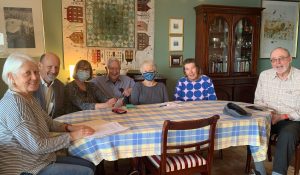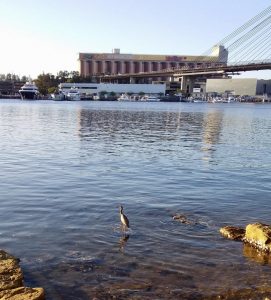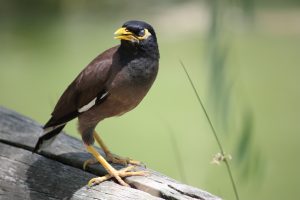by Judy Christie, Blue Wren Subcommittee, December 2021
Survey date: 7 November 2021; Time: 6.45am- 8am

This year’s annual bird survey was held later than usual as a result of uncertainties regarding gatherings due to COVID-19 restrictions. However, it was also our largest team of surveyors with 20 people taking part, counting birds in 11 different parts of Glebe and Forest Lodge. The weather was warm and mild with rain once again holding off until our surveys were completed. There were 11 allocated survey sites across Glebe and Forest Lodge including streets, parks and along waterways, where participants spent around 20 to 45 minutes surveying the birdlife.
The sites included:
- Harold Park parklands and swale
- Tramsheds precinct, ‘The Hill’, Jubilee Oval and adjoining parklands
- Federal Park saltmarsh & Bicentennial Park 2 including Johnstons Creek and Rozelle Bay
- Johnstons Creek corridor from Orphan School Creek Reserve to the Tramsheds bridge
- Forest Lodge streets including along St Johns Road and including Westmoreland St
- Pocket Parks – Arthur (Paddy) Gray Reserve; John St Reserve (Habitat Garden) and St James Park
- Glebe Library precinct and gardens
- Glebe streets within the Toxteth Estate vicinity
- Palmerston Ave, Blackwattle Bay walkway from Bridge Road up to and including Ferry Road & adjacent parks and reserves
- Blackwattle Bay Park Foreshore from Pope Paul V1 Reserve to Ferry Road
- Victoria Park around Lake Northam
Results are summarised below:
|
Species name |
Number of birds |
Comment |
|
Australian Magpie |
40 |
Almost double the number seen in 2020 |
|
Australian Raven |
8 |
Numbers increasing |
|
Australian White Ibis |
17 |
Mostly seen in flight, with Victoria Park increasing the numbers |
|
Australasian Figbird |
4 |
Less than in 2020. No nests seen this year. |
|
Crested Pigeon |
12 |
Consistent numbers |
|
Channel-billed Cuckoo |
1 |
Only one seen but heard by several groups |
|
Common Myna |
76 |
Similar numbers to 2020 |
|
Chestnut Teal |
2 |
Not previously recorded in spring survey but a consistent presence now in Johnstons Creek |
|
Eastern Koel |
3 |
Heard in several different locations but may be fewer birds than recorded |
|
Dusky Moorhen |
3 |
A new species for the survey from Lake Northam |
|
Feral Pigeon (Rock Dove) |
78 |
Significant increase in numbers |
|
Grey Butcherbird |
9 |
Mostly heard only. Numbers may be increasing |
|
Laughing Kookaburra |
3 |
Similar to 2020 |
|
Magpie-Lark (Pee-wee) |
11 |
Large increase. Active nest seen above Johnstons Creek |
|
Little Corella |
2 |
Not seen in 2020 survey, which was an earlier date. |
|
Long-billed Corella |
1 |
A new species for the bird survey |
|
Little Black Cormorant |
4 |
Numbers may be increasing |
|
Masked Lapwing |
1 |
Seen flying in vicinity of Johnstons Creek |
|
Noisy Miner |
186 |
Reported from every site again. Significant increase in numbers. Active nest in the Anchorage area. |
|
Pacific Black Duck |
14 |
Large numbers in family of young ducks in Lake Northam as well as Johnstons Creek. |
|
Pied Currawong |
30 |
A tripling of numbers from 2020 count though many seen on the wing so may be some double counting |
|
Purple Swamphen |
3 |
A new species for the survey from Lake Northam |
|
Rainbow Lorikeet |
271 |
A slight increase but most were flying overhead so could be some double-counting. |
|
Silver Gull |
55 |
Double the numbers seen from 2020 surveys |
|
Spotted Dove* |
18 |
Consistent numbers |
|
Sulphur-Crested Cockatoo |
6 |
More seen than in 2020 |
|
Welcome Swallow |
112 |
Twice the numbers reported in 2020 possibly due to damp conditions with swallows keeping low to catch insects |
|
Willie Wagtail |
1 |
In mangroves on Rozelle Bay |
|
White-faced Heron |
3 |
Not recorded at all in 2020! |
|
TOTALS: 28 species |
970 |
More people, more survey sites: more birds! |
Comments

Not surprisingly, with the additional people to count birds and more parts of Glebe and Forest Lodge covered, as well as the inclusion this year of Lake Northam in Victoria Park, there were several hundred more birds seen, although the total of 28 species was similar to most years. The two most common birds again were the native Noisy Miner and the Rainbow Lorikeet. The Noisy Miner continues to dominate all our open spaces and numerous nests have been seen already this year. The Australian Magpie numbers jumped significantly this year and again seem to be breeding wherever there are the tall trees that they prefer for nest sites. Pied Currawongs are also breeding locally and increasing, feeding on fleshy fruited trees such as Figs and especially the now common street-planted Tuckeroo (Cupaniopsis anarcardiodes), as well as weedy species like Privet (Ligustrum spp) and particularly Celtis (Celtis australis).
Among the non-native species the biggest increase was in numbers of Feral Pigeons, now called Rock Dove, reflecting their original origins in Europe on rocky cliffs.
While no Red Wattlebirds were seen during the survey, they are likely to be still around the area and ongoing nests will be the target of the Eastern Koel which was heard by several groups.
Magpie-Larks or Peewee as many of us call them, were found nesting along Johnstons Creek and the numbers are definitely increasing. While we did not record any Tree Martins during the survey, they were seen earlier in the year at their breeding site on the corner of Ross St and St Johns Rd, in Forest Lodge. The large number of Welcome Swallows seen may have included Tree Martins which are hard to distinguish, especially without binoculars. Apart from the water birds in Lake Northam which are new to our species count, another new species was a lone Large-billed Corella. This larger Corella is also challenging to identify without binoculars but may continue to mingle with the more common Little Corellas.

Although not seen in 2020 when there was a lot of disturbance due to the creek naturalisation works, I am confident from the survey reports that we have now 3 White-faced Herons around the creeks and bays. It was also good to note a Willie Wagtail in in the mangrove habitat at the edge of Rozelle Bay. A pair of Willie Wagtails were seen in Wentworth Park earlier in the year and this parkland would also be interesting to include in future annual surveys.
In terms of future surveys, earlier in the spring – late September or early October may provide a better opportunity to see more bird diversity. As this survey was conducted with daylight saving in place, several of our group suggested that we needed to start even earlier in the morning, when there should be fewer people and dogs to frighten away birds in some of the more popular parks.
Once again, we celebrated our work with breakfast at Esca’s as the rain arrived.
Thank you to all volunteers who helped to make a very successful and enjoyable spring morning. I am sure that the results of this year’s survey also reflect the improving birdwatching skills and knowledge of local bird life among the survey participants. Keep up the good work!
Judy Christie










There are no comments yet. Please leave yours.